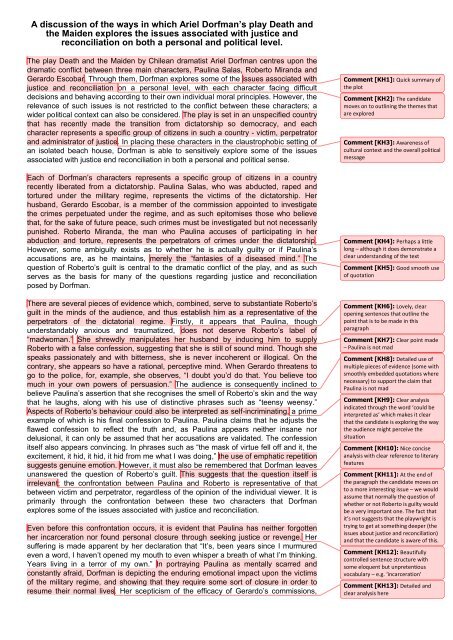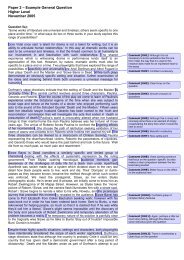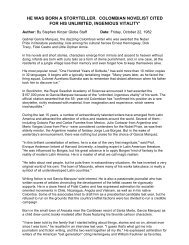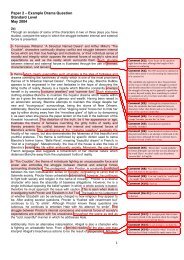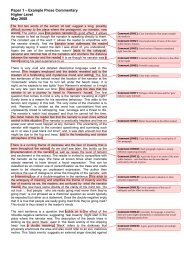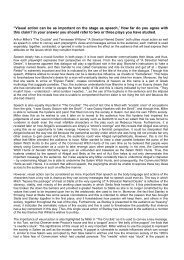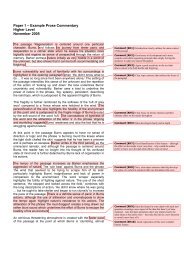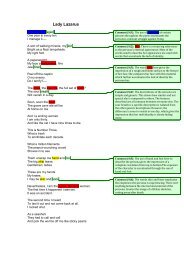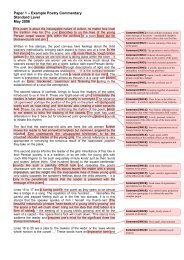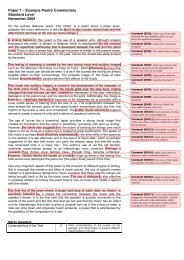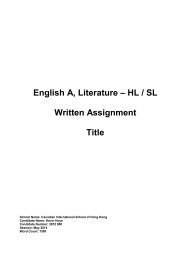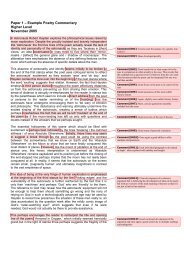Truth & Reconciliation in Death and the Maiden - Mr Hoye's IB ...
Truth & Reconciliation in Death and the Maiden - Mr Hoye's IB ...
Truth & Reconciliation in Death and the Maiden - Mr Hoye's IB ...
- No tags were found...
Create successful ePaper yourself
Turn your PDF publications into a flip-book with our unique Google optimized e-Paper software.
A discussion of <strong>the</strong> ways <strong>in</strong> which Ariel Dorfman’s play <strong>Death</strong> <strong>and</strong><strong>the</strong> <strong>Maiden</strong> explores <strong>the</strong> issues associated with justice <strong>and</strong>reconciliation on both a personal <strong>and</strong> political level.The play <strong>Death</strong> <strong>and</strong> <strong>the</strong> <strong>Maiden</strong> by Chilean dramatist Ariel Dorfman centres upon <strong>the</strong>dramatic conflict between three ma<strong>in</strong> characters, Paul<strong>in</strong>a Salas, Roberto Mir<strong>and</strong>a <strong>and</strong>Gerardo Escobar. Through <strong>the</strong>m, Dorfman explores some of <strong>the</strong> issues associated withjustice <strong>and</strong> reconciliation on a personal level, with each character fac<strong>in</strong>g difficultdecisions <strong>and</strong> behav<strong>in</strong>g accord<strong>in</strong>g to <strong>the</strong>ir own <strong>in</strong>dividual moral pr<strong>in</strong>ciples. However, <strong>the</strong>relevance of such issues is not restricted to <strong>the</strong> conflict between <strong>the</strong>se characters; awider political context can also be considered. The play is set <strong>in</strong> an unspecified countrythat has recently made <strong>the</strong> transition from dictatorship so democracy, <strong>and</strong> eachcharacter represents a specific group of citizens <strong>in</strong> such a country - victim, perpetrator<strong>and</strong> adm<strong>in</strong>istrator of justice. In plac<strong>in</strong>g <strong>the</strong>se characters <strong>in</strong> <strong>the</strong> claustrophobic sett<strong>in</strong>g ofan isolated beach house, Dorfman is able to sensitively explore some of <strong>the</strong> issuesassociated with justice end reconciliation <strong>in</strong> both a personal <strong>and</strong> political sense.Each of Dorfman’s characters represents a specific group of citizens <strong>in</strong> a countryrecently liberated from a dictatorship. Paul<strong>in</strong>a Salas, who was abducted, raped <strong>and</strong>tortured under <strong>the</strong> military regime, represents <strong>the</strong> victims of <strong>the</strong> dictatorship. Herhusb<strong>and</strong>, Gerardo Escobar, is a member of <strong>the</strong> commission appo<strong>in</strong>ted to <strong>in</strong>vestigate<strong>the</strong> crimes perpetuated under <strong>the</strong> regime, <strong>and</strong> as such epitomises those who believethat, for <strong>the</strong> sake of future peace, such crimes must be <strong>in</strong>vestigated but not necessarilypunished. Roberto Mir<strong>and</strong>a, <strong>the</strong> man who Paul<strong>in</strong>a accuses of participat<strong>in</strong>g <strong>in</strong> herabduction <strong>and</strong> torture, represents <strong>the</strong> perpetrators of crimes under <strong>the</strong> dictatorship.However, some ambiguity exists as to whe<strong>the</strong>r he is actually guilty or if Paul<strong>in</strong>a’saccusations are, as he ma<strong>in</strong>ta<strong>in</strong>s, merely <strong>the</strong> “fantasies of a diseased m<strong>in</strong>d.” Thequestion of Roberto’s guilt is central to <strong>the</strong> dramatic conflict of <strong>the</strong> play, <strong>and</strong> as suchserves as <strong>the</strong> basis for many of <strong>the</strong> questions regard<strong>in</strong>g justice <strong>and</strong> reconciliationposed by Dorfman.There are several pieces of evidence which, comb<strong>in</strong>ed, serve to substantiate Roberto’sguilt <strong>in</strong> <strong>the</strong> m<strong>in</strong>ds of <strong>the</strong> audience, <strong>and</strong> thus establish him as a representative of <strong>the</strong>perpetrators of <strong>the</strong> dictatorial regime. Firstly, it appears that Paul<strong>in</strong>a, thoughunderst<strong>and</strong>ably anxious <strong>and</strong> traumatized, does not deserve Roberto’s label of“madwoman.” She shrewdly manipulates her husb<strong>and</strong> by <strong>in</strong>duc<strong>in</strong>g him to supplyRoberto with a false confession, suggest<strong>in</strong>g that she is still of sound m<strong>in</strong>d. Though shespeaks passionately <strong>and</strong> with bitterness, she is never <strong>in</strong>coherent or illogical. On <strong>the</strong>contrary, she appears so have a rational, perceptive m<strong>in</strong>d. When Gerardo threatens togo to <strong>the</strong> police, for, example, she observes, “I doubt you’d do that. You believe toomuch <strong>in</strong> your own powers of persuasion.” The audience is consequently <strong>in</strong>cl<strong>in</strong>ed tobelieve Paul<strong>in</strong>a’s assertion that she recognises <strong>the</strong> smell of Roberto’s sk<strong>in</strong> <strong>and</strong> <strong>the</strong> waythat he laughs, along with his use of dist<strong>in</strong>ctive phrases such as “teensy weensy.”Aspects of Roberto’s behaviour could also be <strong>in</strong>terpreted as self-<strong>in</strong>crim<strong>in</strong>at<strong>in</strong>g, a primeexample of which is his f<strong>in</strong>al confession to Paul<strong>in</strong>a. Paul<strong>in</strong>a claims that he adjusts <strong>the</strong>flawed confession to reflect <strong>the</strong> truth <strong>and</strong>, as Paul<strong>in</strong>a appears nei<strong>the</strong>r <strong>in</strong>sane nordelusional, it can only be assumed that her accusations are validated. The confessionitself also appears conv<strong>in</strong>c<strong>in</strong>g. In phrases such as “<strong>the</strong> mask of virtue fell off <strong>and</strong> it, <strong>the</strong>excitement, it hid, it hid, it hid from me what I was do<strong>in</strong>g,” <strong>the</strong> use of emphatic repetitionsuggests genu<strong>in</strong>e emotion. However, it must also be remembered that Dorfman leavesunanswered <strong>the</strong> question of Roberto’s guilt. This suggests that <strong>the</strong> question itself isirrelevant; <strong>the</strong> confrontation between Paul<strong>in</strong>a <strong>and</strong> Roberto is representative of thatbetween victim <strong>and</strong> perpetrator, regardless of <strong>the</strong> op<strong>in</strong>ion of <strong>the</strong> <strong>in</strong>dividual viewer. It isprimarily through <strong>the</strong> confrontation between <strong>the</strong>se two characters that Dorfmanexplores some of <strong>the</strong> issues associated with justice <strong>and</strong> reconciliation.Even before this confrontation occurs, it is evident that Paul<strong>in</strong>a has nei<strong>the</strong>r forgottenher <strong>in</strong>carceration nor found personal closure through seek<strong>in</strong>g justice or revenge. Hersuffer<strong>in</strong>g is made apparent by her declaration that “It’s, been years s<strong>in</strong>ce I murmuredeven a word, I haven’t opened my mouth to even whisper a breath of what I’m th<strong>in</strong>k<strong>in</strong>g.Years liv<strong>in</strong>g <strong>in</strong> a terror of my own.” In portray<strong>in</strong>g Paul<strong>in</strong>a as mentally scarred <strong>and</strong>constantly afraid, Dorfman is depict<strong>in</strong>g <strong>the</strong> endur<strong>in</strong>g emotional impact upon <strong>the</strong> victimsof <strong>the</strong> military regime, <strong>and</strong> show<strong>in</strong>g that <strong>the</strong>y require some sort of closure <strong>in</strong> order toresume <strong>the</strong>ir normal lives. Her scepticism of <strong>the</strong> efficacy of Gerardo’s commissions,Comment [KH1]: Quick summary of<strong>the</strong> plotComment [KH2]: The c<strong>and</strong>idatemoves on to outl<strong>in</strong><strong>in</strong>g <strong>the</strong> <strong>the</strong>mes thatare exploredComment [KH3]: Awareness ofcultural context <strong>and</strong> <strong>the</strong> overall politicalmessageComment [KH4]: Perhaps a littlelong – although it does demonstrate aclear underst<strong>and</strong><strong>in</strong>g of <strong>the</strong> textComment [KH5]: Good smooth useof quotationComment [KH6]: Lovely, clearopen<strong>in</strong>g sentences that outl<strong>in</strong>e <strong>the</strong>po<strong>in</strong>t that is to be made <strong>in</strong> thisparagraphComment [KH7]: Clear po<strong>in</strong>t made– Paul<strong>in</strong>a is not madComment [KH8]: Detailed use ofmultiple pieces of evidence (some withsmoothly embedded quotations wherenecessary) to support <strong>the</strong> claim thatPaul<strong>in</strong>a is not madComment [KH9]: Clear analysis<strong>in</strong>dicated through <strong>the</strong> word ‘could be<strong>in</strong>terpreted as’ which makes it clearthat <strong>the</strong> c<strong>and</strong>idate is explor<strong>in</strong>g <strong>the</strong> way<strong>the</strong> audience might perceive <strong>the</strong>situationComment [KH10]: Nice conciseanalysis with clear reference to literaryfeaturesComment [KH11]: At <strong>the</strong> end of<strong>the</strong> paragraph <strong>the</strong> c<strong>and</strong>idate moves onto a more <strong>in</strong>terest<strong>in</strong>g issue – we wouldassume that normally <strong>the</strong> question ofwhe<strong>the</strong>r or not Roberto is guilty wouldbe a very important one. The fact thatit’s not suggests that <strong>the</strong> playwright istry<strong>in</strong>g to get at someth<strong>in</strong>g deeper (<strong>the</strong>issues about justice <strong>and</strong> reconciliation)<strong>and</strong> that <strong>the</strong> c<strong>and</strong>idate is aware of this.Comment [KH12]: Beautifullycontrolled sentence structure withsome eloquent but unpretentiousvocabulary – e.g. ‘<strong>in</strong>carceration’Comment [KH13]: Detailed <strong>and</strong>clear analysis here
which has no power to punish those who carried our crimes under <strong>the</strong> regime, <strong>and</strong> canonly address cases <strong>in</strong> which <strong>the</strong> victims died, suggests that she desires a more severeform of retribution aga<strong>in</strong>st her abductors; an op<strong>in</strong>ion no doubt shared by many of thosewho suffered under <strong>the</strong> regime. As she comments to Gerardo, “You hear <strong>the</strong> relativesof <strong>the</strong> victims, you denounce <strong>the</strong> crimes, what happens to <strong>the</strong> crim<strong>in</strong>als?”However, it is only when she imprisons Roberto <strong>and</strong> is suddenly given <strong>the</strong> opportunityto exact justice as she seen fit, that she f<strong>in</strong>ds herself faced with some truly difficultdecisions associated with justice <strong>and</strong> reconciliation. Do Roberto’s crimes, assum<strong>in</strong>gthat he is guilty, warrant <strong>the</strong> penalty of death? Or should Paul<strong>in</strong>e sacrifice revenge <strong>and</strong>personal closure for <strong>the</strong> sake of a safer, more unified future? As Roberto says whenplead<strong>in</strong>g for his life:“So someone did terrible th<strong>in</strong>gs to you <strong>and</strong> now you’re do<strong>in</strong>g someth<strong>in</strong>g terrible tome <strong>and</strong> tomorrow someone else is go<strong>in</strong>g to – on <strong>and</strong> on <strong>and</strong> on. I have children,two boys, a girl. Are <strong>the</strong>y supposed to spend <strong>the</strong> neat fifteen years look<strong>in</strong>g foryou until <strong>the</strong>y f<strong>in</strong>d you?”’Although this sentiment has its merits, one cannot help but sympathise with Paul<strong>in</strong>a’spredicament. As <strong>the</strong> gruesome details of her abduction gradually emerge, <strong>the</strong> audiencefeels compassion for her <strong>and</strong> anger on her behalf. Dorfman’s use of coarse, disturb<strong>in</strong>glanguage <strong>in</strong> describ<strong>in</strong>g her <strong>in</strong>carceration pa<strong>in</strong>ts a graphic picture <strong>and</strong> effectivelyconveys <strong>the</strong> horror of <strong>the</strong> experience. As such, it seems unfair that, after suffer<strong>in</strong>g somuch, Paul<strong>in</strong>a should have to sacrifice her only chance of exact<strong>in</strong>g justice as she seesfit. In evok<strong>in</strong>g such sympathy for her, Dorfman is show<strong>in</strong>g <strong>the</strong> flaws <strong>in</strong> <strong>the</strong> commission’splans for leav<strong>in</strong>g <strong>the</strong> crim<strong>in</strong>al unpunished.Gerardo’s attitude towards <strong>the</strong> conflict between his wife <strong>and</strong> Roberto reflects <strong>the</strong> viewsof <strong>the</strong> commission. Not hav<strong>in</strong>g been directly victimised by <strong>the</strong> regime, he cannot trulyunderst<strong>and</strong> <strong>the</strong> extent of Paul<strong>in</strong>a’s suffer<strong>in</strong>g say<strong>in</strong>g to her, “How can you possibly bethis way, talk this way,” <strong>and</strong>, “What are you try<strong>in</strong>g to do, woman, with <strong>the</strong>se <strong>in</strong>saneacts?” This apparent lack of empathy <strong>and</strong> sense of detachment perhaps provides <strong>the</strong>foundations for his belief that, if <strong>the</strong> crimes perpetrated under <strong>the</strong> regime can beexplored <strong>and</strong> established objectively, his country will be able to “close an exceptionallypa<strong>in</strong>ful chapter - <strong>in</strong> our history” without <strong>the</strong> need for fur<strong>the</strong>r violence. However, thanksto our sympathy for Paul<strong>in</strong>a <strong>and</strong> thus, <strong>in</strong>directly, for <strong>the</strong> victims of <strong>the</strong> regime, <strong>the</strong>audience recognises <strong>the</strong> flaws <strong>in</strong> this idea of justice. Difficult questions are raised; forexample, if <strong>the</strong> crimes are buried end <strong>the</strong> perpetrators left unpunished, what is toprevent future repetition of past atrocities? Never<strong>the</strong>less, Gerardo is conv<strong>in</strong>ced thatreconciliation is <strong>the</strong> only way forward for his country <strong>and</strong>, on a more personal level, hiswife. His views thus reflect those of <strong>the</strong> citizens of an emerg<strong>in</strong>g democracy who believethat it is worth forgiv<strong>in</strong>g past crimes for <strong>the</strong> sake of future democratic stability <strong>and</strong> unity.Instead of giv<strong>in</strong>g a def<strong>in</strong>ite resolution to <strong>the</strong> dramatic conflict between <strong>the</strong>se threecharacters, Dorfman leaves unanswered <strong>the</strong> question of Roberto’s fate at <strong>the</strong> h<strong>and</strong>s ofPaul<strong>in</strong>a. This is <strong>in</strong>dicative of his belief that it is <strong>the</strong> issues explored dur<strong>in</strong>g <strong>the</strong> conflictitself that are important, not <strong>the</strong> outcome. It also suggests that he is not offer<strong>in</strong>g anyprescriptive answers to <strong>the</strong> questions he raises, <strong>and</strong>, <strong>in</strong> a political context, is <strong>in</strong> no waytak<strong>in</strong>g it upon himself to dictate how an emerg<strong>in</strong>g democracy can solve its problems.Towards <strong>the</strong> end of <strong>the</strong> play, he uses <strong>the</strong> dramatic device of “a giant mirror whichdescends, forc<strong>in</strong>g <strong>the</strong> members of <strong>the</strong> audience to look at <strong>the</strong>mselves”’ to <strong>in</strong>vite <strong>the</strong>audience to consider what <strong>the</strong>y would do <strong>in</strong> situations such as those faced by hischaracters, <strong>and</strong> to convey that <strong>the</strong> issues explored <strong>in</strong> his play can be applied on apersonal level by every memberIn his powerful <strong>and</strong> evocative play <strong>Death</strong> <strong>and</strong> <strong>the</strong> <strong>Maiden</strong>, Ariel Dorfman explores someof <strong>the</strong> issues associated with justice end reconciliation on both a personal <strong>and</strong> politicallevel His characters face difficult decisions regard<strong>in</strong>g guilt, sacrifice, forgiveness,punishment <strong>and</strong> peace, all of which have political significance for a new democracy. Indepict<strong>in</strong>g both Paul<strong>in</strong>a’s suffer<strong>in</strong>g <strong>and</strong> Gerardo’s desire for future stability, Dorfman issuggest<strong>in</strong>g that <strong>the</strong>re are no easy answers to such questions, <strong>and</strong> leaves it up to hisaudience to reflect upon <strong>the</strong> issues raised.Comment [KH14]: Detailedanalytical comments started with a keyverb like ‘suggests’ – if you are notus<strong>in</strong>g verbs like this <strong>in</strong> your essay <strong>the</strong>nyou are not do<strong>in</strong>g much analysisComment [KH15]: A clear <strong>in</strong>sight<strong>in</strong>to <strong>the</strong> more <strong>in</strong>terest<strong>in</strong>g issues raisedby <strong>the</strong> textComment [KH16]: Although it isgenerally better to smoothly <strong>in</strong>cludequotations. When you quote largesections of texts, it is correct to set<strong>the</strong>m out <strong>in</strong> this wayComment [KH17]: Clear awarenessof <strong>the</strong> effect on <strong>the</strong> audience.Comment [KH18]: Clear analysiswith reference to <strong>the</strong> effect on <strong>the</strong>audience. Note that <strong>the</strong> use of literaryterms is unpretentious <strong>and</strong> focused.Simple terms like ‘coarse language’ <strong>and</strong>‘graphic picture’ are used successfully<strong>and</strong> conv<strong>in</strong>c<strong>in</strong>gly here.Comment [KH19]: Clear confidentanalysis of <strong>the</strong> effect created by <strong>the</strong>authorComment [KH20]: Good, smoothuse of quotationsComment [KH21]: Aga<strong>in</strong> good cleargrasp of <strong>the</strong> audience’s response to <strong>the</strong>playComment [KH22]: Clear clos<strong>in</strong>gsentences that reflect <strong>the</strong> po<strong>in</strong>t made<strong>in</strong> this paragraphComment [KH23]: The c<strong>and</strong>idatemoves towards <strong>the</strong> conclusion byexplor<strong>in</strong>g <strong>the</strong> subtle literary feature‘<strong>the</strong> fact that <strong>the</strong> questions are leftunanswered’ – although <strong>the</strong>re is nosimple technical term for this it is aliterary feature as real <strong>and</strong> considerablymore powerful than assonance oralliteration.Comment [KH24]: Clearunderst<strong>and</strong><strong>in</strong>g of one of <strong>the</strong> potentialmessages of <strong>the</strong> playwrightComment [KH25]: The c<strong>and</strong>idaterema<strong>in</strong>s aware that this is a play, withdramatic effects, <strong>and</strong> not just a novelComment [KH26]: Clear concisesummary of <strong>the</strong> overall <strong>the</strong>sis of <strong>the</strong>essay.
Marks Awarded:Selection of Aspect 5 A key <strong>the</strong>me picked out here <strong>and</strong> explored with depth <strong>and</strong> <strong>in</strong>sight.The fact that <strong>the</strong> issue chosen is of fundamental importance to <strong>the</strong>play <strong>and</strong> <strong>the</strong> fact that <strong>the</strong> c<strong>and</strong>idate never deviates from this topichelps <strong>the</strong>m to score highly hereKnowledge <strong>and</strong> Underst<strong>and</strong><strong>in</strong>g 4 Excellent knowledge of <strong>the</strong> text. Clear analysis of Dorfman’sprobably <strong>in</strong>tentions <strong>and</strong> <strong>the</strong> likely effects on <strong>the</strong> audience. Althoughit would have been a good idea to refer to <strong>the</strong> fact that Chile,Dorfman’s home country, was under <strong>the</strong> rule of <strong>the</strong> dictator Piochet.Presentation 5 Clear structure with all po<strong>in</strong>ts explored <strong>in</strong> depth <strong>and</strong> a sensible,logical progression of ideasLanguage 5 Great language – sophisticated <strong>and</strong> eloquent without be<strong>in</strong>gpretentious. Use of literary features is sound, but <strong>the</strong> student is nottry<strong>in</strong>g to hard.19 Level 7


